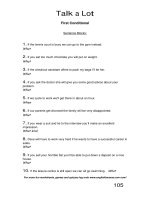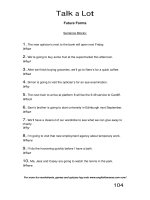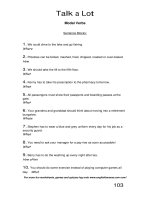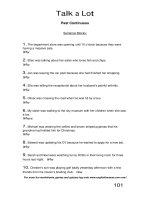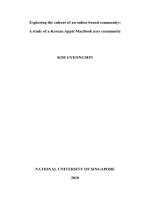talk a lot transcription of an online lesson on sentence stress
Bạn đang xem bản rút gọn của tài liệu. Xem và tải ngay bản đầy đủ của tài liệu tại đây (89.15 KB, 8 trang )
Talk a Lot
Focus on Connected Speech
Transcription of an Online Talk a Lot Lesson on Sentence Stress=
Talk a Lot Elementary Book 3 – Unit 5: Airport
Introduction
What follows is a complete transcription of a free
online lesson that was delivered by Talk a Lot author
th
Matt Purland on Thursday 24 September 2009 at
1pm CET. He used the online teaching platform
provided by to deliver the
lesson, which lasted about fifty minutes and was
attended by eleven students, including Angela,
Luba, and others who are mentioned below.
The lesson was interactive because the students
were able to type answers to Matt’s questions in a
chat box that everybody could see on the screen.
They were able to see Matt talking live on the
screen, and get answers to their questions. As well
as the live video of the teacher on the screen, the
students could follow a Powerpoint presentation,
which included material used during the lesson. The
still shot from the lesson in progress (right) gives an
example of what the participants could see.
The lesson was recorded and later distributed as an episode of the English Banana.com Podcast. You can download
the .mp3 file and listen to this lesson in full by clicking this link:
/>You can download the full Powerpoint presentation of the lesson here:
/>
Transcription
[Podcast introduction] Hello. My name is Matt Purland. I’m an English teacher living and
working in Poland. This is a recording of a free lesson that I delivered recently on
www.edufire.com. We’re using material from the Talk a Lot free spoken English course, which
is available to download free from If you’d like to
attend the next Talk a Lot lesson please visit to find
out the date and time. And I hope you’ll be able to join us then.
Let’s start our lesson today. We’re looking at sentence stress. And the topic we’re looking at
is Airport, which is one of the topics in Talk a Lot Book 3. It’s the latest one that’s being written
at the moment. What does it mean sentence stress? Sentence stress. Anybody? Type in the
box if you know. What is sentence stress? Do you know? Or what is a sentence? Let’s start
with that. So type in the box if you know. So a sentence is a group of words. For example,
let’s start with this example.
“My name is Matt.”
“My name is Matt.” This is a sentence. It’s a short sentence. Sentence stress is about which
words in a sentence have stress; are said more strongly or louder than other words. So, in
this sentence which words do you think are more important than the others? Which words are
more important? So, Luba’s saying “name” and “Matt”. So in this sentence I would stress
For more fun worksheets, games and quizzes log onto www.englishbanana.com now!
Talk a Lot Elementary
English Banana.com
12.30
Talk a Lot
Focus on Connected Speech
Transcription of an Online Talk a Lot Lesson on Sentence Stress=
Talk a Lot Elementary Book 3 – Unit 5: Airport
“name” and “Matt”. These are words which we call content words. They have some meaning.
Or a dictionary meaning. I wouldn’t say for example:
“My. Name. Is. Matt.”
That’s everything stressed the same. But I would say, “My name is Matt.” Or even with
contraction: “My name’s Matt”. OK. Let’s start at the beginning with this then. We’re going to
look at content words. Content words are words in the sentence that have meaning; that have
their own meaning in the dictionary. For example, if I said to you “name”, then you’d know
what it means. “Name.” So content words are things like nouns, verbs, adjectives, adverbs,
numbers, words that have meaning on their own outside the sentence.
Type in the box please, for example, some nouns. What does it mean noun? Type in the box
just for example, any nouns. “Tree”. OK. “Sound”. “Mic”, or “microphone”. “Car”. “Computer”.
“Water”. So these are nouns. Things we can either see or can’t see, such as abstract nouns,
like “peace” or “sound”, is something we can’t see. “Freedom”. Good example. So nouns are
things that we can either see or touch, or maybe things that are just abstract. OK. Like for
example “freedom”.
Next one. Verbs. Type in the box some examples of verbs. Any verbs. “Speak”, “go”, “love”,
“study”, OK. Any more? So, we’re talking about main verbs. The main action in the sentence.
These are content words. Nouns, main verbs, such as the ones we’ve just heard.
Adjectives. What about adjectives? What are they? Adjectives. “Beautiful”, says Luba,
“green”, “nice”, “slow”, “new”, very good. “Lovely”. So, what do adjectives describe? What do
they describe? Adjectives describe nouns. Very good, Ed. Thank you. Nouns, main verbs,
adjectives. These are content words. Words which have a meaning in the dictionary, and a
meaning apart from the sentence.
What about then adverbs? Adverbs. Can you think of any examples of adverbs? “Slowly”,
“well”, “fastly”? No, we can’t say “fastly”. “Fast” is better. “Nicely”. Ed’s saying anything with
“-ly” suffix. Yeah. “Quick” can be adverb; “quickly” as well, “slowly”. OK. So what does an
adverb describe? An adverb describes the verb. So, how we’re doing something. How we’re
doing it. An adjective describes the noun. The things. And adverbs describe the verbs. OK.
Numbers as well, I think we know what they are. I don’t need to say that. One, two, three, for
example. Words that have a meaning on their own outside of a sentence. OK. Content words.
The other words we’re looking at are function words. Function words. Any examples? Maybe
you already know about this. Function words. So, for example, prepositions, articles, auxiliary
verbs, and verb “to be” – these are function words. Type in the box for me some examples of
prepositions, just for example. Just for example. Prepositions. So, “on”, “at”, “from”, “under”;
they’re describing where something is – the place or the time, maybe something like that.
Articles. What are articles? Articles, for example, “the”, “a”, and “an”. So we’ve only got three
articles in English, thank goodness. Articles. Determiners. For example, “some”, “many” –
determiners. What does it mean auxiliary verbs? Auxiliary verbs? “Do”, “be”, “have”. OK,
these are good auxiliary verbs. Good examples. “Should” – so modal verbs as well. “Can”,
“might”, “could”, “must”, but what’s the difference between auxiliary verbs and main verbs?
[Pause.] Auxiliary verbs don’t mean what they usually mean, Luba. They don’t mean. What do
For more fun worksheets, games and quizzes log onto www.englishbanana.com now!
Talk a Lot Elementary
English Banana.com
12.31
Talk a Lot
Focus on Connected Speech
Transcription of an Online Talk a Lot Lesson on Sentence Stress=
Talk a Lot Elementary Book 3 – Unit 5: Airport
they mean then? So what do they mean? [Pause.] Modal verbs are auxiliary. Oh, auxiliary
means helping, doesn’t it, helping. It’s sort of assisting. Helping verbs. They help other verbs
to make the tenses. To make the tenses. So if you making a tense with a sentence with
present continuous you need to use “be” as auxiliary verb, like: “I am talking to you now”. “I’m
talking”. “Be” is an auxiliary verb. Doesn’t have any meaning in the sentence. It doesn’t have
any meaning, but it’s just there to make the grammar. Just to make the grammar. OK, and the
main ones are: “be”, “have”, “do”, and then the modal verbs as well. OK.
Also function words, things like… verb “to be” – it’s never stressed either, so we can include
verb “to be” – even when it’s a main verb we can use it as a function word. So, really this is
the main point. This is the main point of the lesson. And in fact it’s the most important point of
any lesson to do with spoken English that I’ve ever taught, because it’s the most critical thing
to know, the difference between content words and function words. If we’re just using all
words together with the same level of stress, then our English will stay very strange, very
static, very foreign. We need to know in a sentence which words are content words and which
are function words. You can do this with any sentence. Find a sentence in English, look at it,
and underline the content words. Nouns, main verbs, adjectives, adverbs, numbers, and any
word that has a meaning apart from the sentence. Away from the sentence. And function
words are the little words, the short words: prepositions, articles, determiners, auxiliary verbs,
and verb “to be”. These are words that are contracted and squeezed together. OK. So this is
the introduction to the lesson. Let’s look at the Powerpoint together. This comes from the title
of the Talk a Lot Handbook, which you can download from
“Success in spoken English lies in stress and vowel sounds.” Stress and vowel sounds. OK?
“Specifically, getting the correct vowel sounds on the correct stressed syllables in a sentence,
and then joining them together.”
So this is what we learn to do on Talk a Lot courses. And also through the Handbook, it gives
you a lot of practice for doing this. The first thing we need to do in a sentence is identify, is
find, content words and function words. OK. After we’ve done that we can look for the stress –
the stressed syllable – in each content word. And after that look for the vowel sound. If we
know that, then our pronunciation will really improve. And will be much clearer. If we don’t
know that, then our pronunciation and stress can be very mixed, and quite difficult to
understand. Let’s look at another extract from the book, Talk a Lot Handbook:
“There are two kinds of word in most sentences: content words and function
words. Content words are words that give the meaning in a sentence, such as nouns
(e.g. bread), main verbs (e.g. eat; note: “be” is an exception because it is a main verb, but is
always unstressed), phrasal verbs (e.g. put on), adjectives (e.g. sliced), adverbs
(e.g. quickly), numbers, wh- question words (e.g. what), and negative auxiliary verbs
(e.g. isn’t). Function words are words that are essential to make the sentence grammatically
correct, but that don’t have any intrinsic meaning on their own, i.e. without content words.
They are words such as pronouns (e.g. she, them), auxiliary verbs (e.g. “are” in “They are
going…”), prepositions (e.g. in, on), articles and determiners (e.g. a, the, some),
conjunctions (e.g. and), quantifiers (e.g. many), and the verb “be” when used as a main
verb.”
So, these are the little words that fall in between the content words. These are the words that
cause all the problems with grammar. With tenses. And really make things difficult for
For more fun worksheets, games and quizzes log onto www.englishbanana.com now!
Talk a Lot Elementary
English Banana.com
12.32
Talk a Lot
Focus on Connected Speech
Transcription of an Online Talk a Lot Lesson on Sentence Stress=
Talk a Lot Elementary Book 3 – Unit 5: Airport
students of English. If we just had content words I think your life would be easier in the
English class. OK, so let’s continue then.
“The strong stresses fall on the content words in a sentence while the weak stresses fall on
the function words.”
OK. Sometimes we stress a function word if we want to stress something particular, so
intonation means that I want to focus on something particular in the sentence. [But] I’m talking
about everyday, normal stress without particular intonation.
I’ll have a deep breath there! Let’s continue then with the sentence from Airport. Airport. This
is going to be the new topic from Talk a Lot, available next month I would imagine. These are
sentence block sentences, so you can also use them to make sentence blocks, if you know
how to do that.
“Graham flies about three or four times a year.”
If you’re using this as a sentence block, I think you could use maybe “How many?” “How
many times does Graham fly…?” for example. Let’s look at this sentence. This is a normal
sentence isn’t it? What tense is it, this sentence? What is the tense here? “Graham flies about
three or four times a year”. Present tense. OK, but which one? Present what? Present
continuous? [Pause.] Present simple. Thanks, Gruba, for helping us. So, present simple.
Graham flies… Listen to how I say it. And I will speak quickly, how I would normally speak to
an English speaker: (rapid speech) “Graham flies…”
Can you hear how some of the words are stronger or louder than the others? Some of the
words are stressed. Yeah, Hassan can. Looking at the sentence then we have to break down,
try and imagine it in two groups: words which have stress – words which are content words –
and words that are function words. OK. When you look at the sentence, try to imagine content
words being bold, like black letters. Just try to imagine that now. Which words then are
content words? “Graham”. “Flies”. “Three”. “Four”. “Times”. “Year”. OK. “Graham”. “Flies”.
“Three”. “Four”. “Times”. “Year”. These are the content words. So which are the function
words? Function words. “About.” So, preposition. “Or”, the conjunction. And also “a” – article.
So, “About.” “Or.” “A.” If I read you the sentence without these function words, can you still
understand me?
“Graham flies three four times year.”
Can you understand the meaning of the sentence? Yes, Luba can. Ed can. OK. So these are
the most important words in the sentence. These have meaning. These carry the meaning of
the sentence. “Graham flies three four times year”. These are the words we want to hear in
the sentence: nouns, main verbs, numbers, adjectives, adverbs, you know, this kind of thing.
Let’s look at the words that we missed out. Function words. “About”, “or”, “a”. If I said to you,
“Hey, Angela, about or a!” Do you understand me, what I mean? [Pause.] Yes? So, some
confusion here. [Pause.] No. Exactly. So, if I just said to you: “About or a”, it’s not a sentence,
because there’s no meaning. There are no words that have any meaning in this sentence. It’s
just function words. OK. Good, Angela. So, there’s no verb. We always have to have a verb in
an English sentence. There’s no noun. There’s nothing. There’s no meaning. Good. So,
For more fun worksheets, games and quizzes log onto www.englishbanana.com now!
Talk a Lot Elementary
English Banana.com
12.33
Talk a Lot
Focus on Connected Speech
Transcription of an Online Talk a Lot Lesson on Sentence Stress=
Talk a Lot Elementary Book 3 – Unit 5: Airport
“Graham flies three four times year”. These words have meaning, and so the content words
are stressed in the sentence. The content words are stressed, and the function words are not
stressed.
What does it mean… what does it mean then? [Pause.] I have to look for the stress in each
content word. The stressed syllable. If the word has more than one syllable, I need to find
which one is stressed. So, Graham. Graham. Graham. How many syllables are there?
Graham. Two syllables, thank you Cristina. So, Graham. Which one is stressed. Which one is
louder than the other? Graham. Graham. DUH-duh. So, I’m stressing the first. Very good
everybody. I’m stressing the first syllable. It’s something like this: big O, small o. [The stress
pattern in the word Graham = Oo.] If I want to show it like that. Graham. DUH-duh. DUH-duh.
“Graham flies three four times year”. OK. The rest of this is quite simple because all the other
words – content words – have only one syllable. So the stress is on the whole syllable.
“Graham flies about three or four times a year”.
It’s not about saying it quickly, and speaking quickly, it’s not really. Although you can speak
quickly if you want to. It’s about stressing the right syllables. Stressing the right syllables. That
means not stressing function words, articles, prepositions, but stressing nouns, verbs, and so
on. Content words. And if you’ve got a word that’s longer than one syllable, looking for the
stressed syllable. Graham. I don’t say Gra-HAM, Gra-HAM, Gra-HAM. “Gra-HAM flies...” No.
Not Gra-HAM flies, but GRA-ham. So, it’s the name of somebody. It’s somebody’s name,
Charles. Graham. It’s a male person. It’s a man. I can’t say Gra-HAM. Gra-HAM! “Gra-HAM
flies…” No. Because the accent is on the first syllable. OK. So if I get the wrong syllable for
the accent, or stress, it makes it harder to understand me. If I’m telling you, “Gra-HAM. GraHAM flies…” What? What did you say? What did you say? “Gra-HAM?” What, “grey”, as in
the colour? “Ham”, as in the meat? What do you mean? Accent is so important in English. It’s
so important. And it leads to a lot of confusion, if we’re using the wrong stress, or the wrong
accent.
You can find out where the strong stress is in every word by checking in your dictionary, and it
will show you the phonetic spelling, and which syllable is stressed. So, GRA-ham. GRA-ham.
OK. “Graham flies about three or four times a year”. The other words in the sentence – the
other words, that’s the function words – I have to say more quickly. I have to say more
quickly, or more quietly, with less stress. I have to make a contrast between them. You know,
three or four, three a four. “A”. I’m only saying “a”. I’m not pronouncing “orrrr”. “Three orrrr four
times aaaa year”. No. “Three a four”; “three a four”; “three a four times a year”. “A year”. “A
year”. Very quickly with the function words. “Graham flies about three a four… three a four…
three a four…” “A”. I’m using the weak stress schwa sound for “or”. It’s the weak form of the
word. If you look in the Talk a Lot Handbook you will see a long list of weak forms. I can do
this, not because I’m an English teacher (that I’m allowed), but I can do it because these
words are not stressed. They’re function words. I have to squeeze them together. I can’t get
rid of them. I can’t delete them, and just say, “Graham flies three four times year”. I can’t
really delete them, because then it would be a mistake. It would be an error. But, I can reduce
them… is the word. Reduce. Make them shorter. Make them quicker. So they don’t stand out.
“Three or four times a year”. “Three or four times a year”. “Three a four”. “Three a four”.
“Three a four”.
Reduce, reduce, reduce. That’s what you should do with function words in a sentence. Try
with your own sentences. Say them more quickly; but it’s fine to do it when you’re speaking in
For more fun worksheets, games and quizzes log onto www.englishbanana.com now!
Talk a Lot Elementary
English Banana.com
12.34
Talk a Lot
Focus on Connected Speech
Transcription of an Online Talk a Lot Lesson on Sentence Stress=
Talk a Lot Elementary Book 3 – Unit 5: Airport
English because they’re not stressed, and they shouldn’t have stress. “Three. Or. Four.
Times…” No. “Three a four times a year”. Can you hear the rhythm? “Three a four”. Imagine
like the mountain range. Up, down, up, down, up, down. English goes up and down. Du dUH,
Du dUH, Du dUH. Let’s think of a good example for that. For example, this sentence. Let’s try
saying this. Try saying it to yourself:
“I’d like to eat a plate of sweets.”
Du dUH, Du dUH, Du dUH, Du dUH. OK. So there’s some similarities in Spanish, Angela’s
saying here. “I’d like to eat a plate of sweets.” Du dUH, Du dUH, Du dUH, Du dUH. What’s the
main verb here? What’s the main verb? Eat. OK, and also…? So we’ve got two. Two verbs.
Two main verbs. “Like” and “eat”. Which are the nouns? Type in the box. “Plate”. Good,
Hassan, and “sweets”. OK. So all the other words are not stressed. Look at the sentence and
try… and in your mind make the words, the main content words, in bold, if you like. So, we’ve
got “like, eat, plate, sweets”. If I just said this to you, you could probably understand me, what
I meant, right? “Like, eat, plate, sweets”. Maybe you don’t know who, because there’s no
pronoun, and there’s no person. But this demonstrates the rhythm of English, and how the
function words can fall into the holes, into the gaps between the content words. “I’d like to eat
a plate of sweets.” Du dUH, Du dUH, Du dUH, Du dUH. And of course, it doesn’t always
sound like that, exactly. Because we’ve got many combinations of words and syllables. But
this is for example. OK. So, if you are just saying: “I’d. Like. To. Eat. A. Plate. Of. Sweets.
Teacher! I’d. Like. To. Eat. A. Plate. Of. Sweets”. “Would. You? O. K. Then. Here. You. Are.
Then”. It’s not English. It’s not English, because there’s no rhythm and there’s no sentence
stress – that’s why I said earlier, the most important lesson you can learn from this is how to
separate content and function words, and notice then that content words have stress.
Function words don’t. OK. So, that’s another example.
“Graham flies about three or four times a year.”
Let’s continue a little bit more with Graham, and then we’ll take some questions towards the
end. Now you can see in this sentence, the content words are bold. “Graham flies about three
or four times a year”. I’m not saying it particularly fast. I’m not speaking quickly, but I’m
stressing the right words, the right syllables. I’m not saying “Gra-HAM”. “Gra-HAM flies…”
because it’s the wrong stress. “Graham”. “Graham flies…” “Graham flies about three or four
times a year”. So I’ve identified the stresses.
“Graham flies about three or four times a year.”
It’s maybe not the best example, because all the other words are one syllable. But you can
see here some other examples. [On the Powerpoint presentation students could read the
other sentence block starting sentences from the Airport unit.] Underline the stressed syllable.
Let’s look at the second example. Number two. So you’ve got the words which are content
words in bold. The function words are grey. The stress in each content word is underlined:
“Keith is flying economy class today, because he can’t afford an upgrade.”
And this is standard in all Talk a Lot materials. You could download any unit from Book 3 and
you will see this. So the stressed syllables here: “Keith”, “fly”, “con”, “class”, “day”, “can’t”,
“fford”, “up”. If you’re getting this right, if you’re getting the stressed syllables right, your
For more fun worksheets, games and quizzes log onto www.englishbanana.com now!
Talk a Lot Elementary
English Banana.com
12.35
Talk a Lot
Focus on Connected Speech
Transcription of an Online Talk a Lot Lesson on Sentence Stress=
Talk a Lot Elementary Book 3 – Unit 5: Airport
pronunciation will be good, and the person listening will understand you. If you’re getting
some of these stresses wrong, like here, “e-con-O-my class…” What? I didn’t hear the right
stress. So you put up a barrier between me and you. “e-con-O-my”? No, “e-CON-o-my”.
“Economy class”. Oh, right. Economy class. So you have to underline the stress and use the
correct stress. “Flying”. “Flying”. It has to be the first syllable, because “-ing” is never stressed.
It’s a suffix, and these are never stressed. We go into detail in the handbook about this.
“Flying”. “Playing”. “Looking”. “Seeing”. “Reading”. “Going”. It’s always going to be stressed
on the first syllable. I can’t saying “fly-ING”. “-ing” is a suffix and it’s not stressed. “e-CON-omy class”. “Today”. “Today”. Not “TO-day”. “TO-day, teacher!” No. “T”. [pronounced like the
consonant sound LíL ] “T”. Even without a vowel sound. The function words can be reduced.
We can reduce them. “T-day”. “Because he can’t afford an upgrade”. “An up-GRADE”? No.
“UP-grade”. “UP-grade” is correct, in the same way that “GRA-ham” is correct, or “e-CON-omy class” is correct. “e-con-O-my”? No, it’s not “e-con-O-my”, for example. “e-CON-o-my”. It’s
four syllables. You’ve got a one in four chance of getting it right, if you don’t know the stress.
But when you’re learning the word, learn the stress as well. Don’t just guess it. Look in your
dictionary, see the phonetic spelling and which syllable is stressed. It’ll be marked with the
little mark that looks like an apostrophe. I can’t show you here, because we haven’t the
phonetic symbols, but “e-CON…” “e-CON…” The “con” will have the little mark in front of it,
like an apostrophe. “e-CON-o-my”.
The ultimate goal here is to look at the sentence and identify the vowel sounds. That’s why
I’m talking about vowel sounds. Each stressed syllable has a vowel sound. The stress is on
the vowel sound:
===LÉfL========L~fL=================LáWL=======LlWL=L~fL==========Lf]L=
Graham flies about three or four times a year.
==LáWL=======L~fL========LflL===========L^WL=======L~fL=========================L^WL=======LlWL=======L¾L==
Keith is flying economy class today, because he can’t afford an upgrade.
“GRA-ham”. “Gray”. “Ay”. “Graham”. If I get confused and say “GRA...” [as in the short vowel
sound LôL ] “GRA-ham”. Then what? I don’t understand you. It’s a barrier between us.
“GRA-ham”? No, the correct vowel sound is “ay”. So it must be “GRA-ham” [the diphthong
sound LÉfL=]. “Keith is flying”. “Flying”. “I”. “I” [the diphthong L~fL=]. And you can see here the
phonetic symbols. “I”. If you said “Keith is fleeing”, “fleeing”, then it’s a different verb. The verb
“to flee”, and it means running away. So, straight away we’ve got confusion if you don’t know
the vowel sound. You should learn for every content word the stressed syllable and the vowel
sound. I can’t stress it enough! “Keith is flying economy”. “Economy”. Probably you will guess
the “o” sound [the short vowel sound LflL] because of the spelling. “Economy class today”.
“Today”. “To die”? “To die”? It’s a different verb in English – “to die” – isn’t it? It means to stop
living. “To die”? No. “Today”. “Today”. It doesn’t matter about the “t” because there isn’t a
vowel sound at all, because it’s not stressed, it’s weak form, it’s functional. “T”. [The
consonant sound LíL] “Today”. But “day” has to be the “ay” sound. “Day” has to be the “ay”
sound. “Because he can’t afford an upgrade”. “UP-grade”. “OOP-grade”? “OOP”? “OOP”?
Like “book”? [The short vowel sound LrL] No. “Up”. “Up”. Like “uh”, the sound in the phonetic
alphabet that is “uh”. [The short vowel sound L¾L]
For more fun worksheets, games and quizzes log onto www.englishbanana.com now!
Talk a Lot Elementary
English Banana.com
12.36
Talk a Lot
Focus on Connected Speech
Transcription of an Online Talk a Lot Lesson on Sentence Stress=
Talk a Lot Elementary Book 3 – Unit 5: Airport
That’s why we said at the beginning of the lesson, “success in spoken English lies in stress
and vowel sounds. Specifically getting the correct vowel sounds on the correct stressed
syllables in the sentence.” Practise on your own, or with a friend, or with your teacher. Take
any English sentence. Separate it into content words and function words, and then look for
the stress on the content words – which syllable is stressed? Only one per word. Only one
has the strong stress. Then think about what is the vowel sound. Try to learn the phonetic
alphabet. It will take you maybe one week, if you’re using flashcards, but after that it’ll be
useful every day for a lifetime. So you have to learn that. Think about what is the vowel
sound, and then practise it. And then all the other syllables in between can be squeezed
together. Just squeeze them; reduce them as far as possible, and then you’ll be stressing the
correct things, and your pronunciation will improve. This is really an introduction, and after this
there’s nothing more to do than simply practise it and try it.
[Podcast ending] Thanks for joining us today. To download more free lessons, and all of the
Talk a Lot materials absolutely free of charge, please visit:
/>
For more fun worksheets, games and quizzes log onto www.englishbanana.com now!
Talk a Lot Elementary
English Banana.com
12.37




